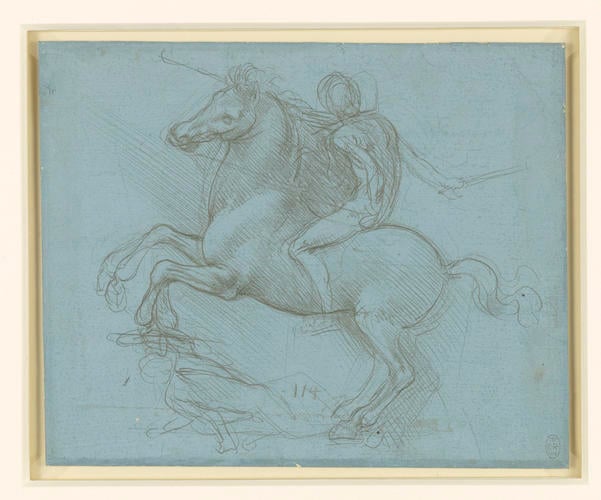-
1 of 253523 objects
Recto: A design for an equestrian monument. Verso: Studies of flowing water, a cross-bow, geometry, etc. c.1485-8
Recto: Metalpoint on blue prepared paper. Verso: Pen and ink | 14.8 x 18.5 cm (sheet of paper) | RCIN 912358

Leonardo da Vinci (1452-1519)
Recto: A design for an equestrian monument. Verso: Studies of flowing water, a cross-bow, geometry, etc c.1485-8

Leonardo da Vinci (1452-1519)
Recto: A design for an equestrian monument. Verso: Studies of flowing water, a cross-bow, geometry, etc c.1485-8


-
Recto: a study of a nude figure on a horse, rearing in profile to the left. Leonardo has drawn the rider as a featureless figure rather than a likeness of Francesco Sforza (see RCIN 912357), with his arms in several alternative positions. Below, a fallen foe raises his shield to protect himself, thereby supporting the front legs of the horse. Verso: rough drawings of walls; equilateral triangles; a wave; a crossbow; water falling from a pipe; a wheel in a box; a weight diagram. Melzi's number 114.
In the mid-1480s Ludovico Sforza, the ruler of Milan, commissioned Leonardo to make a huge equestrian monument in bronze to his father Francesco. Leonardo’s initial designs showed the horse rearing, but Ludovico came to doubt that Leonardo would be able to execute such a challenging pose, and later studies show the horse walking.
Between 1490-92 Leonardo studied horses intensively. He made drawings in both casual poses and strict orthogonal views, in the manner of architectural elevations, and he measured individual horses minutely. He then constructed a full-size clay model for the horse, from which he took a mould to cast the monument. But in 1494, the 75 tons of bronze assembled for the casting was requisitioned to make cannon, and the project was suspended. Five years later French forces invaded Milan and deposed Ludovico. Leonardo’s model for the horse was used for target practice by the French troops, and destroyed before his eyes.
Text adapted from Leonardo da Vinci: A life in drawing, London, 2018Provenance
Bequeathed to Francesco Melzi; from whose heirs purchased by Pompeo Leoni, c.1582-90; Thomas Howard, 14th Earl of Arundel, by 1630; probably acquired by Charles II; Royal Collection by 1690
-
Creator(s)
Acquirer(s)
-
Medium and techniques
Recto: Metalpoint on blue prepared paper. Verso: Pen and ink
Measurements
14.8 x 18.5 cm (sheet of paper)